AMD’s Radeon HD 6870 & 6850: Renewing Competition in the Mid-Range Market
by Ryan Smith on October 21, 2010 10:08 PM ESTKicking things off as always is Crysis: Warhead, still the toughest game in our benchmark suite. Even 2 years since the release of the original Crysis, “but can it run Crysis?” is still an important question, and the answer continues to be “no.” One of these years we’ll actually be able to run it with full Enthusiast settings…
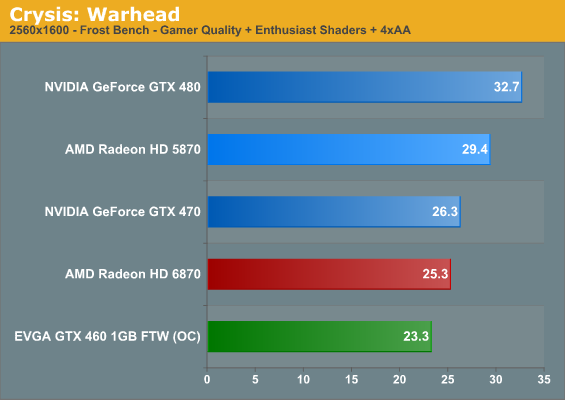
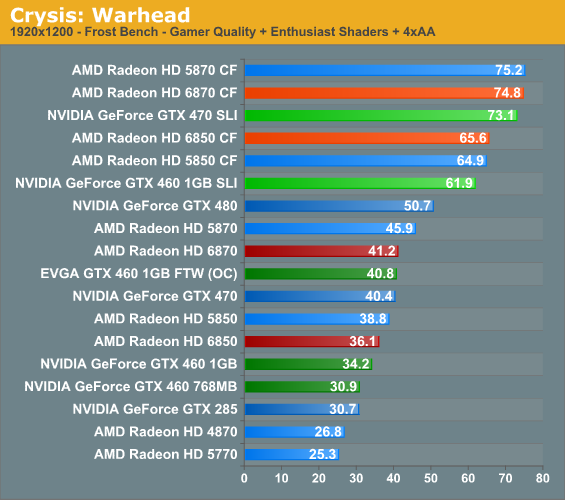
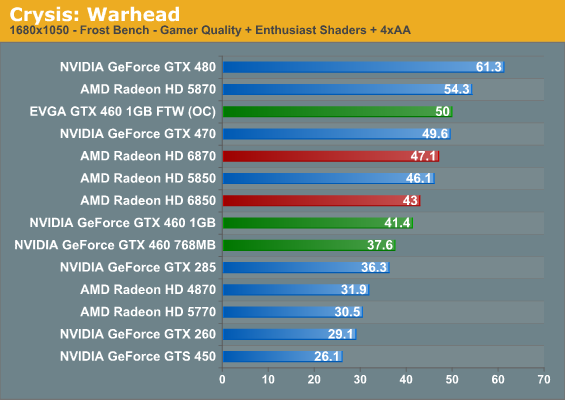
For reasons we’ve yet to determine, Crysis continues to do a very good job serving as an overall barometer for video card performance. Much of what we see here will show up later, including the order that cards fall in.
As we’ve been expecting, the 6800 series cannot keep up with the 5800 series – Barts is still a “rebalanced” Cypress after all. The performance gap isn’t too severe, and it certainly couldn’t justify 5870 prices at today’s prices, but the 6870 and 6850 definitely aren’t perfect replacements for their 5800 series counterparts.
Focusing on 1920x1200, we have a 3-way race between the GTX 470, EVGA GTX 460, and the 6870. The 6870 comes out ahead, with the EVGA and then the GTX 470 bringing up the pack at under a frame behind. Meanwhile near the 6850 is the GTX 460 1GB, and it’s 2fps behind; while even farther down the line is the GTX 460 768MB, which officially is only $10 cheaper than the 6850 and yet it’s well behind the pack. As we’ll see, the 6850 will quickly assert itself as the GTX 460 1GB’s peer when it comes to performance.
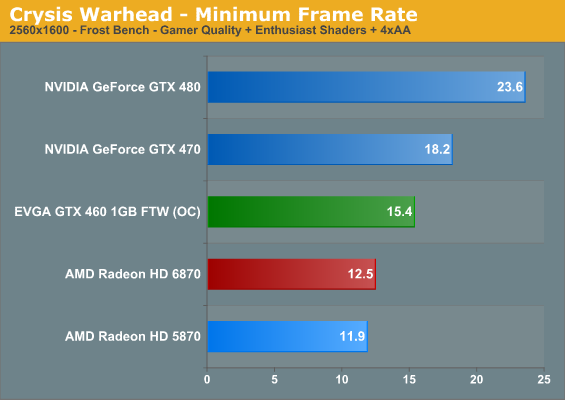
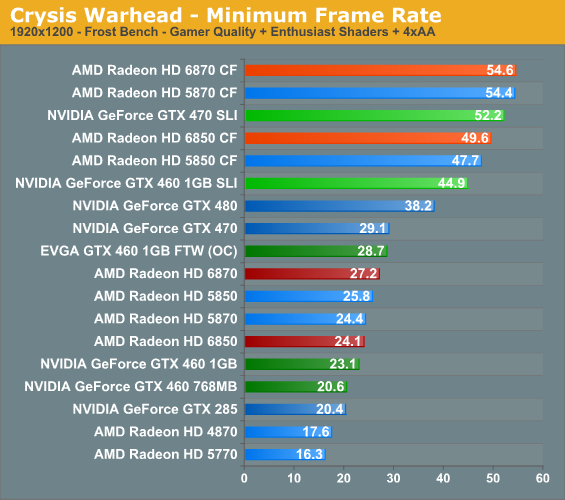
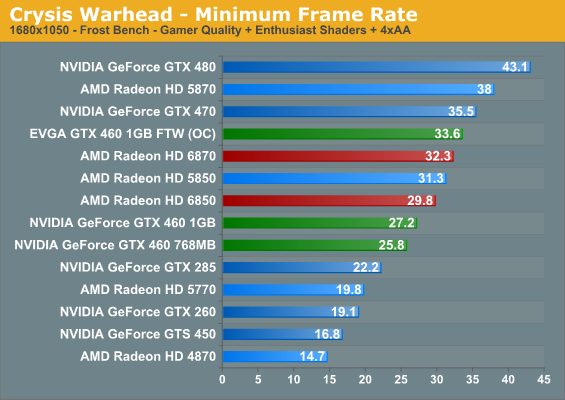
Meanwhile taking a quick look at Crossfire performance we see an interesting trend: the 6800 series cards are much closer to their 5800 series counterparts than they are in single card mode. Here the 6850CF even manages to top the 5850CF, an act that nearly defies logic. This is something we’ll have to keep an eye on in later results.
Moving on to our minimums, the picture changes slightly in NVIDIA’s favor. The 6870 drops to the bottom of its pack, while the 6850’s lead narrows versus both GTX 460 cards. Meanwhile in CF mode now both 6800 series cards top their 5800 series counterparts. Crysis’ minimum framerate has always been a bit brutal to AMD cards due to how AMD’s drivers manage their memory, a problem compounded by Crossfire mode. Perhaps something has changed?










197 Comments
View All Comments
Ryan Smith - Friday, October 22, 2010 - link
Quality is unchanged. UVD 3 adds a few fixed function blocks, but quality is a matter of post-processing and hence affected by the drivers once you have sufficient shader power to do all the post-processing.Pastuch - Friday, October 22, 2010 - link
I posted about this earlier but my post was deleted.Ryan there is a ton of HTPC users on this site.
1. Exactly how long is the Radeon 6870/6850 vs the GTX 460?
2. How does the GTX460 compare to the Radeon 6 series regarding bitstreaming high def audio?
3. How UVD3 post-processing compare to Nvidias?
Ryan Smith - Friday, October 22, 2010 - link
It's exactly the same as this: http://www.anandtech.com/show/3973/nvidias-geforce...HigherGround - Friday, October 22, 2010 - link
Why was EVGA card included in this test? The rest of the field is generic (non OC, no brand), so why included an OC card, which skews the readers perspective? Pretty sure EVGA paid you to included its top OC card in this review ...Parhel - Friday, October 22, 2010 - link
No, NVidia paid them to include it. NVidia sends "guidelines" to all the hardware review sites, telling them what settings to use and which cards to use in the comparison. In the guidelines for today's review was to use the EVGA GTX 460 FTW, and and site you see using it is essentially a paid NVidia shill.I could care less about ATI vs NVidia, as I'm not really a gamer, but I'm very disappointed today to see my long time favorite hardware site stooping to this level. In the end, it gives consumers bad information, which should be antithetical to the purpose of a site like this.
AtwaterFS - Friday, October 22, 2010 - link
I agree, this site is typically class-leading, but this article give AnandTech a bit of a black eye and the results dont particularly jive with "un-biased" sites like HardOCP.DrKlahn - Friday, October 22, 2010 - link
I was going to post the same thing. As a long time reader of this site, I was very disappointed with the decision to include the overclocked card. Either the ATI cards should have been overclocked and their results provided in every test or it should have been excluded as per the normal benchmarking guidelines.I would have no issue with a followup or side article comparing factory overclocked offerings. But this is clearly bowing to pressure from Nvidia and I expected better of this site.
aungee - Saturday, October 23, 2010 - link
To Include the EVGA GTX 460 FTW was unfair and whether intentional or not it did spoil the launch party for AMD on this site to some degree. It would have been more appropriate to make a small mention of it's existence and to benchmark it in the future against any factory OC 6800 cards.After getting your head around the naming, AMD needs to be credited for bringing such a performance on only a 255 mm2 package (it even caused the price drop for the 530mm2 GTX 470) . AMD has headroom to drop the price of the 6800 cards so lets hope they do soon.
tigersty1e - Friday, October 22, 2010 - link
I couldn't find the clocks, but if you do include an OC'd card in your benches, you should give us the clocks.dertechie - Friday, October 22, 2010 - link
850 MHz Core, 1700 MHz shaders, 4 GHz Memory, up from 675 MHz Core, 1350 MHz shaders, 3.6 GHz Memory.That's a 26% Core OC and an 11% Memory OC. However, the cost has been OC'd too, the FTW card costs the same $240 as the stock Radeon 6870.